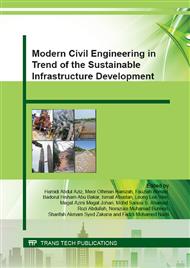p.611
p.617
p.623
p.629
p.634
p.640
p.649
p.655
p.661
A Study on the Characteristic and Properties of Riverbank Soil Samples as RBF Natural Materials from Sungai Perak, Kota Lama Kiri, Kuala Kangsar, Perak Darul Ridzuan, Malaysia
Abstract:
For a developing country such as Malaysia, riverbank/bed filtration (RBF) technology is still new and only few efforts have been made to understand the RBF mechanism and processes. Soil characteristics play important roles in determining the water quality and the ability of water to be abstracted from the wells during RBF process. A research has been carried out to identify the characteristic of riverbank soil at different layers in the pumping well (PW) borehole at Kota Lama Kiri, Kuala Kangsar, Perak, Malaysia. Soil samples were collected during the development of PW for RBF application. The maximum depth of PW was 8.50 metre. The soil samples were transported to Geotechnical Engineering Laboratory, School of Civil Engineering, Universiti Sains Malaysia and the properties were determined by a series of laboratory test. Soil particle size distribution (PSD) and hydraulic conductivity were obtained from sieve analyses and constant head test with reference to BS 1377: Part 1-9;2:1990. Laboratory results show that the value of Cu (coefficient of uniformity) for the soil samples within the borehole of PW was found to be within the range of 2.00 to 10.00 while the value of Cc (coefficient of gradation) lies in the ranges of 0.06-1.19. The One Way Analyses of Variance test was performed using Minitab statistical packages and the results indicate that the p-value was 0.996, where there was no significance difference between the mean sizes of soil samples within the PW. The hydraulic conductivity, k for PW ranges between 0.10-0.91 cm/s. Soil samples from depth 6.00-7.00 metres has the highest hydraulic conductivity, which is 0.91 cm/s. The overall well production from the pumping test was found 112.10 m3/hr.
Info:
Periodical:
Pages:
634-639
Citation:
Online since:
October 2015
Price:
Сopyright:
© 2015 Trans Tech Publications Ltd. All Rights Reserved
Share:
Citation:


